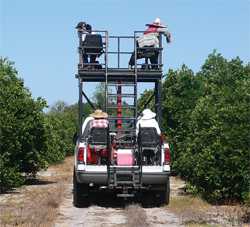Setting The Scouting Bar

Two years ago, Holly Chamberlain never expected to be running her own statewide scouting service. But looking at her background, it’s easy to see how she got where she is today.
Education And Experience
Chamberlain holds bachelor of science degrees from Rutgers University in plant science and natural resource management, as well as a master of science in plant pathology from Penn State University. She completed additional graduate coursework in soil and water science from the University of Florida.
She worked at the Southwest Florida Research and Education Center for three years as the citrus canker education program coordinator before taking a position in Arcadia as the BMP program coordinator for the Peace River area. In 2005, after greening was first found in Florida, she relocated to the Citrus Research and Education Center in Lake Alfred at the request of UF’s Dr. Pete Timmer to become the exotic pest and disease coordinator.
After a meeting on greening in late 2006 that Smoak Groves hosted, Mason and John Smoak made Chamberlain a job offer to coordinate their greening disease management program. She accepted and came on board in early 2007.
“I wanted to try something different and work in the private sector,” says Chamberlain.
She got a scouting program up and running and developed it into a separate business unit for Smoak Groves. Soon she was performing scouting services for other groves. In January 2009, she purchased the scouting business from Smoak Groves that she had established.
Today, Chamberlain’s Avon Park company, Pest and Disease Management LLC (PDM), has grown from its original eight employees to 40 scouts that service groves throughout the state.
Top Priority Is Training
“It takes an average person four months to be properly trained to detect disease,” says Chamberlain. “If someone leaves the group, I can’t hire a replacement tomorrow. It takes practice to get good at it. You can’t just put a group together, throw them out there, and hope for the best results. That would be a disservice to the industry.”
She says that as the presence of greening increases in the state, so does the number of start-up scouting companies. But because there are no certifications or set standards for the scouting industry, growers should ask about the educational background and experience behind a scouting company before hiring it.
Chamberlain helps ensure accuracy of scouting services by regularly comparing trees workers have tagged with PCR lab results, using iodine starch tests, and recording inspector-flagged trees with GPS. Inspector records can be checked daily, weekly, or monthly following the progress of a new hire and making sure experienced inspectors are staying focused.
PDM has provided training for several other scouting companies, but one day in the field does not qualify someone as a trained inspector, cautions Chamberlain. “It takes significant field time and exposure to symptoms and knowledge of other grove problems the inspector may encounter such as pest pressures or nutritional deficiencies.”
PDM has benefited from ongoing training through UF as well as learning from others around the world. The company has hosted groups from Mexico, California, Texas, Australia, Argentina, and Brazil. In addition, Chamberlain has visited Brazil and Argentina to gain a better understanding of greening and canker management strategies. “This exchange of information helps us to continue to learn and grow,” she says.
Recent continuing education efforts at PDM included staff attendance at UF worker training days in St. Lucie in January and Arcadia in March. Leticia Santana and Maria Heredia hold the scouting championship from the Indian River Citrus Seminar in 2008 and 2009, respectively.
“It’s important to have ongoing training so employees know they are doing a service to the industry and stay motivated,” says Chamberlain. “The biggest challenge is making sure we are doing the best job we can. And we need to make sure growers remove the trees as quickly as possible after we find greening. Growers can’t be idle or relaxed about tree removal.”









